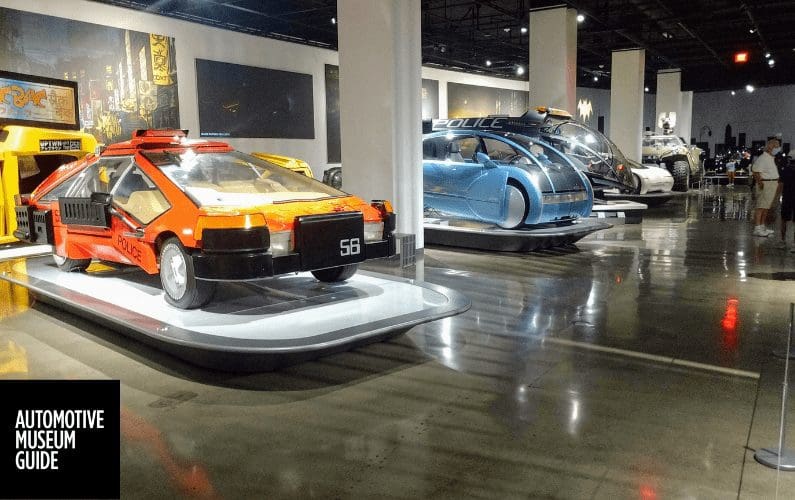Visiting Keystone Truck and Tractor Museum
The Keystone Truck and Tractor Museum in Colonial Heights, Virginia is a fantastic automotive museum full of over 150 antique tractors and more.




Okay, the honest truth is I did not drive all the way from my home in San Antonio to Los Angeles just to see the Petersen Automotive Museum. I actually came to see another exhibit, a temporary one, at another museum, one that has nothing to do with cars.
But, hey, why waste the trip?
The Petersen Museum, the unofficial Home Base for American automotive culture, is always a Must-See automotive museum. Located on the corner of Wilshire Boulevard and Fairfax Avenue, the Petersen anchors the western end of the Miracle Mile.


That name seems to mean something particular to Angelinos, but not to me. I’m more impressed by the striking design of the museum’s building, a repurposed department store wrapped now in a voluptuous steel skin that makes it the architectural focal point of the area, even more than the Motion Picture Academy’s weird new Death-Star-shaped theater, hiding behind their museum across the street. Once you see the Petersen — or the Death Star Theater, for that matter — you never forget it.
Like most car museums, the Petersen doesn’t have room to display its entire collection at one time. There are two ways to deal with this problem. Many museums cram in all the cars they can, and visitors have to be satisfied with standing by a bumper and looking over the body from there. Maybe the other end of the car can be glimpsed from the next crowded row.
On today’s visit, my second time at the Petersen, I stepped off the elevator to begin my visit with a 1924 Mercedes Targa Florio. This is the oldest Mercedes I’ve ever seen, and it looked odd. Designed to serve either as a road car or a racer, the floorboard features a couple of oddities. One, according to a docent, enabled the passenger to dump gasoline, to lighten the car in a race. (The passenger envisioned was the driver’s mechanic; I’ve never had a passenger I would trust with such power.)
Personally, I fit only one of those categories.) The exhibition also includes other, less exotic but hardly more “normal” vehicles, from the 1913 Mercer Raceabout to the 1967 AC Shelby Cobra, the 1933 Deusenburg SJ convertible to the 1955 Jaguar XKSS, the very one that Steve McQueen used to irritate the neighbors with as he drove through LA’s canyons. (According to the knowledgeable docent keeping an eye on the floor, that car was the loudest one he had ever heard, when it was moved onto the floor for display.)
Being in Los Angeles, it’s natural that the Petersen should be well-known for a collection of movie and TV-related cars. They used to be on the top floor, and perhaps will be again after the current show; the signs showing their location up there haven’t been removed, though nobody seemed the least bit confused about it.
There are, of course, the required Batmobiles — three of ‘em, if I remember right; plus cars and car-like vehicles used in futuristic movies like Blade Runner and Minority Report. And there’s the holy-of-holies, Luke Skywalker’s ground speeder from Star Wars Episode IV: A New Hope. The one he left behind a long time ago in a galaxy far, far away.
The ground floor also contains an exhibition dedicated to the work of Pinin Farina, one of the great Italian automotive design studios. The centerpiece of that exhibit is the beautiful 1953 Nash-Healey convertible, though other beautiful designs, from Alfa Romeos and Ferraris to a coffee maker, were also featured. I admit I didn’t spend much time admiring the coffee maker, but I think I took way too many pictures of the Nash-Healey
The museum has its own parking garage, with entrances on Fairfax Avenue and on 8th Street, at the back of the building. There’s also some metered parking in the area, but those are limited to two hours and, to be honest, most of the meters are so poorly maintained that you won’t be able to tell how much you’re spending.
The Petersen Museum also offers access to its “vault,” the parts of its collection not presently on display in the museum proper. I haven’t seen it, but from descriptions and photographs of it, those cars are lined up bumper-to-bumper. But there are more than two hundred of them, so it’s a trade-off.
Photo credit Passepartout22
Automotive Museum Guide Contributor
The Keystone Truck and Tractor Museum in Colonial Heights, Virginia is a fantastic automotive museum full of over 150 antique tractors and more.
The Tampa Bay Automobile Museum is a must stop place if you're in the Tampa, FL area. If you're cruising out of Tampa take a few extra hours and stop by.
The Panoz Museum in Hoschton, Georgia is a must stop for any automotive enthusiast, especially race fans. Not only is the Panoz hand made right on site but they also display various models in the museum, as well as some of the actual race cars and racing...
I recently had the opportunity to visit the Mustang Museum of America in Odenville, Alabama and I've got to say I was really impressed especially once I was told how recently the museum started.
automotive museum guide
Sign up to get updates about automotive museums right to your mailbox. Don't miss a thing. It's FREE.
The phrase "car museum" gets thrown around so much you'd almost assume there is at…
Benson Memory Lane Museum is the private collection of Jim Benson, owner of Benson Automotive.…
The Brothers Car Collection is a private collection of more than 600 cars. Over 335…
If you don't care or don't have time to do anything other than just glance…
Klima-Lounge Museo CCC, that is the art, to pair talent and capability, to connect culture…
This website uses cookies.